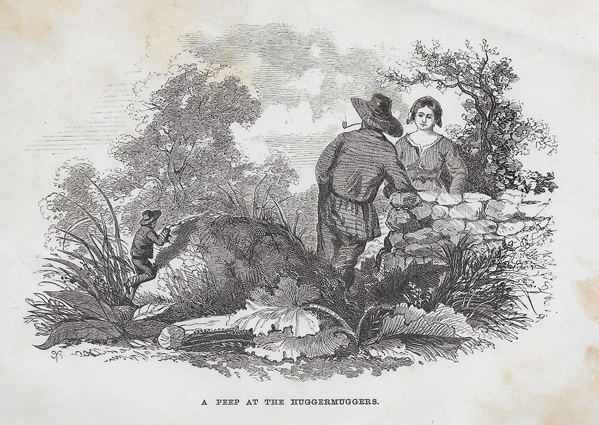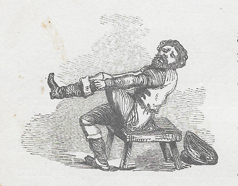
This is a children’s story written and illustrated by Christopher Pearse Cranch in 1855. He admits in the book that such fantasy classics such as Gulliver’s Travels and Robinson Crusoe were direct influences. A young man by the name of Jacky Cable signs on to work on a ship that is ultimately shipwrecked. Jacky and some of the crew swim to an island where they find everything to be gigantic. They are small enough to sleep in conch shells on the beach.
Huggermugger Children’s Giant Story
Jacky encounters two giants on the island, Mr. and Mrs. Huggermugger. There is also a small community of dwarves, larger than Jacky, but smaller than the Huggermuggers. Jacky and his stranded shipmates are rescued and then tell their fantastical tale of giants and dwarves to others. One of men who believed Jacky is Zebedee Nabbum, who is out collecting wild animals to be exhibited in the circus of P. T. Barnum.

Nabbum hatches a plan to return to the island of the giants to capture Mr. Huggermugger and return to America where he can put him on display for money, think King Kong. The company of kidnappers, including Jacky return to the island where circumstances and additional information change the course of their operation.

Christopher Pearse Cranch
Christopher Pearse Cranch (1813 – 1892) graduated Harvard Divinity School and became a Unitarian minister traveling on the East Coast. He later became a magazine editor, children’s fantasy writer, and landscape painter. He was a big fan of Ralph Waldo Emerson.
I came across an original edition of the Last of the Huggermuggers at an antiquarian book fair. The book is in sad shape and the oil from hundreds of little children’s fingers have stained the pages. But I was fascinated with the illustrations and original story published in 1856.
Last of the Huggermuggers was written when P. T. Barnum was active not only in illustrated newspapers, but also Barnum’s American Museum in New York City. The Museum had a freak show attraction. Barnum would promote these attractions that he called Humbugs, which were usually exaggerations or frauds. It’s possible that the name Huggermugger is a derivative of Barnum’s Humbug title for his exhibits.
In the book, Zebedee Nabbum was in the process of collecting exotic animals to be shown for the P. T. Barnum show. Cranch describes Nabbum as, “He was now at Java superintending the manufacture of a very powerful net of grass-ropes, an invention of his own, with which he hoped to catch a good many more wild animals, and return to America, and make his fortune by exhibiting them for Mr. Barnum.”

Some of the last comments of Mr. Huggermugger speak to a larger truth about nations who use their power to colonize other countries.
“No”, he said, “my little friends, I feel that I shall never see your country. Your coming to my island has in some way been fatal to me. My secret must have been told. The prophecy, ages ago, has come true!”
The Last of the Huggermers, A Giant Story
I am not scholarly enough to interpret all the different allusions, metaphors, and analogies to both biblical references or the societal institutions and American history present at the time of the writing of the book. However, it is clear that Cranch was referencing some of the American history as it related to the treatment of Native Americans and the overall manifest destiny concept.
Of the 16 illustrations in the book, 10 of them have initials. We know that Cranch was an active sketch artist from previous work. He would have given his illustrations to H. O. Houghton & Co. in Riverside, Cambridge – near Harvard – to be engraved into a substrate such as wood. This engraving along with the text, would have then been stereotyped for printing.
What is unclear to me is if the initials or symbol on 10 of the illustrations are that of Cranch or of the engraver? It looks to be a stylized hybrid of a combination of latin or Greek alpha characters. Either way, they are nice historical pieces of the dress of the time in the mid-1800s.
Of course, some of the phrases, terms, and words used in the book, particularly related to sailing and ships, are a little arcane today. But I found it interesting the Cranch put a footnote in the book regarding an American noun to help other children understand the reference.
*The “clam” is an American bivalve shell-fish, so called from hiding itself in the sand. A “clam-chowder” is a very savory kind of thick soup, of which the clam is a chief ingredient. I put in this note for the benefit of little English boys and girls, if it should chance that this story find its way to their country.
The Last of the Huggermuggers, A Giant Story
I suppose it was best to discuss what a clam is because it truly is essential to the story. The clams and shell-fish are the specific food that helped the Huggermuggers become giants.
Illustrations of Christopher Pearse Cranch
Below are scanned images from the illustrations in the book. The resolution has been reduced for the web page. Some of the images are nearly full page and others may be only an eighth or quarter page size. 300 dpi resolution images are at https://insuremekevin.com/insure-me-kevin/imk-file-explorer/#12246-huggermuggers
The Last of the Huggermuggers is a nice, but not great, children’s tale. Both adults and children can relate to the fantastical tale on different levels. Because the book is no longer in circulation, I decided to record a podcast of me reading the book in hopes that it might reach a larger audience. It is one way I like to make history available to more people before it is completely forgotten.




















